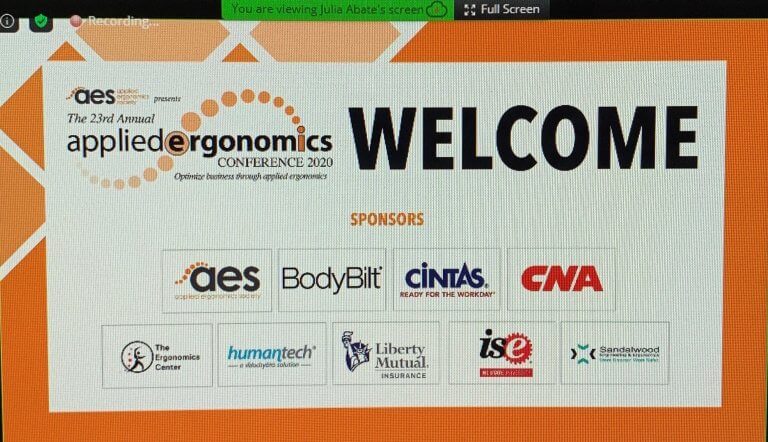Applied Ergonomics Conference – Day 1 Recap
08/05/2020

Even though we could not attend the Applied Ergonomics Conference in person, we’re grateful for the virtual learning experience and for having the opportunity to collaborate with the attendees who stopped by our booth. The theme of day one was Advancements in Ergonomics, with the focus on wearable technologies and exoskeletons. Read the summaries from our ergonomics experts.
 Title: Utilization of Smart & Wearable Technology to Evaluate the Impact of Ergonomic Solutions
Title: Utilization of Smart & Wearable Technology to Evaluate the Impact of Ergonomic Solutions
Summarized by Rick Barker, Sr., Technical Manager
Summary: ”Just because you can measure it doesn’t mean you should,” said Ben Zavitz, President and Chief Ergonomist, Ergo Human Performance LLC, during his presentation. He made this statement early on, and it sums up the topic quite well. Technology has enabled our ability to measure human movement and physical musculoskeletal disorder (MSD) stressors in ways that I couldn’t have imagined when I began my career. In most cases, you don’t need to be an expert to gather data; the latest technologies provide ergonomics practitioners and team members with much greater assessment capabilities than they would have previously had.
However, the increased opportunity to gather data doesn’t always mean that the information is accurate or valuable. It is important to understand what technology can and can’t measure well. Perhaps even more important is understanding the information or conclusions that are drawn from the data. Much of the technology outlined in Zavitz’ session was developed for applications other than ergonomics and, unfortunately, input from ergonomics and safety experts hasn’t been consistently utilized when transferring the technology to our discipline. As a result, the outputs aren’t always useful.
Technology will continue to change the way we perform ergonomics assessments. To make sure those changes are actually improvements, it’s imperative that we know the capabilities and limitations of what we use.
Title: Static and Dynamic Assessments of Back-Support Exoskeletons
Summarized by Rick Barker, Sr., Technical Manager
Summary: As an ergonomist, I’m asked more questions about exoskeletons than any other subject. It’s no surprise, actually. It’s hard for practitioners, who work on multiple aspects of ergonomics, to keep up with this rapidly evolving area. I can understand why they believe exoskeletons are the answer for improving ergonomics in many industries—the product websites say so! Luckily, we have researchers like Dr. Maury Nussbaum, from Virginia Tech, to explain the pros and cons of exoskeletons based on scientific studies.
Some of the important takeaways from Nussbaum’s session include:
- The value of conducting both lab and field research
- The need to measure multiple potential impacts
- The importance of investigating and distinguishing different task types
I appreciate Nussbaum’s easy-to-understand explanation of the research methods used in the studies. Even before the results were presented, the testing conditions (tasks) and the measures collected provided a good lesson on the many issues that need to be simultaneously considered when evaluating exoskeleton technology.
Title: Exploring Neuroergonomic Fit of Passive Exoskeleton During Simulated MMH Tasks
Summarized by Blake McGowan, Director of Ergonomics Research
The key takeaway from this session, presented by Yibo Zhu, of Texas A&M University, is how cognitive demands increase when using an occupational exoskeleton. It’s important to measure these demands during use since increased cognitive demand is a known risk factor for low back disorders.
Title: Potential Use of Optimization Techniques to Refine Anthropometric Design of Products
Summarized by Rick Barker, Sr., Technical Manager
Dr. Matt Camilleri, High Plains Engineering Services, explained how the Virtual Fit Tool, developed for the Human Factors and Ergonomics Society, aids in the design of furniture and equipment based on anthropometrics. Users add workplace dimensions to determine which percent of the population (and who) can be accommodated by the specified design. In fact, Camilleri built the response plots—the tool extensions—to help users make design decisions.
The ability to combine multiple variables to determine the percent of the population included in the design provides a considerably more accurate estimation than traditional single variable methods and would be particularly useful during the cost/benefit decisions relating to approving new product designs. The most natural use of this tool appears to be in computer and furniture design.
However, I would contend that the Virtual Fit Tool, and the added functions discussed in this session, is a tool to be used by experts, rather than as a general design tool. In order to apply the data outputs, the user must understand how to generate functional anthropometric criteria from static measurements. For example, there is more to understanding the fit of a display height than just knowing the percent of the population covered by a range of eye heights. One must combine the static anthropometry measurement with information about viewing angles and neck postures to obtain the best design information. Therefore, this tool is best suited for use by experienced ergonomists who are prepared to apply the data appropriately.
Visit our Recap of Day 2 at the 2020 Virtual Applied Ergonomics Conference.






